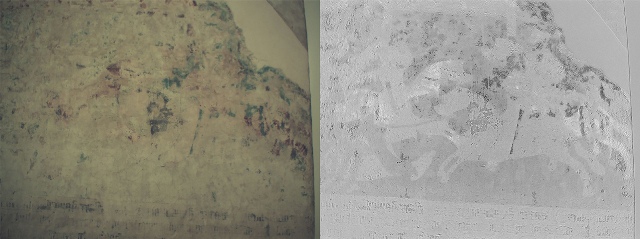Jul 2 2015
Many details of the wall and ceiling frescos in the cloister of Brandenburg Cathedral have faded: Plaster on which horses once “galloped” appears more or less bare. A hyperspectral camera sees images that remain hidden to the human eye, however, and is thus a big help a for art historians.
 The upper cloister of Brandenburg Cathedral: Details of the wall frescos such as horses are now coming to light in spots where only traces of pigments had been discernible (left). A hyperspectral camera with specially engineered software has revealed the images (right). © Fraunhofer IFF
The upper cloister of Brandenburg Cathedral: Details of the wall frescos such as horses are now coming to light in spots where only traces of pigments had been discernible (left). A hyperspectral camera with specially engineered software has revealed the images (right). © Fraunhofer IFF
The ravages of time have severely damaged the wall and ceiling frescos in the upper cloister of Brandenburg Cathedral (Brandenburg an der Havel). Much is no longer discernible with the naked eye. Often only fragments of what were once women with elegant garments and headgear standing together can be seen today. No matter how long one looks, images are undiscernible from the traces of pigments. A hyperspectral camera captures quite a different image with software developed by researchers from the Fraunhofer Institute for Factory Operation and Automation IFF in Magdeburg: It is bringing many of these faded frescos to light again.
Over Fifty Color Channels Detect the “Invisible”
The camera “looks” not only at the visible light reflected by the frescos – just as the eye or a conventional camera does – but also at the wavelengths in the infrared range. Moreover, its resolution is significantly finer. “Whereas humans assemble every perceived hue out of the colors red, green and blue, the camera has fifty-one color channels,” explains Dr. Andreas Herzog, a researcher at the Fraunhofer IFF. “It is therefore capable of distinguishing hues that appear identical to the human eye.” Where only blue is visible, for instance, the system divides the reflected light into the minimum of different hues, thus detecting structures that are actually no longer visible. This new technology additionally helps determine whether pictures were painted in several stages or have been restored at one time. Even if the paints might have looked the same to the artist, they could never have been mixed fully identically. The camera uncovers the differences.
Some methods for detecting works of art exist already. Illuminating them with a UV lamp causes some substances in pigments, often the binder, to fluoresce. Using a conventional camera to capture their fluorescence also reveals hidden structures. The drawback is that the procedure is very involved and the UV light affects the paintings. This is not the case with the hyperspectral camera. It works with a normal light source that has less of an effect on works of art. What is more, the two procedures can be combined: The hyperspectral camera can also retrieve more out of the fluorescent light because it not only sees the light itself but also ascertains the composition of the fluorescing pigments.
Rather than the camera, the specially developed software is the centerpiece of this development. It uses the data produced during hyperspectral imaging to compile around one hundred images on some of which structures such as painted figures of women or horses come to light. Art experts examine and interpret these images. What mixture of pigments appears most frequently in the image selected? The algorithm computes this with the aid of statistics and standardization. It displays the proportion of exactly these pigment components in a separate image. The software algorithm proceeds in exactly the same way with the second most frequent pigment components in a second image and so forth. The researchers are collaborating with surveyors at bgis Kreative Ingenieure GmbH in order to map large frescos on curved walls in high resolution, too. Their software assembles the individually computed images into one complete panorama and provides the art historians at the Cathedral Museum and Brandenburg State Cultural Heritage Preservation Agency an overview of larger correlations between images.
First Trial in Brandenburg Cathedral
The researchers from the Fraunhofer IFF have already tested their technology successfully in the upper cloister of Brandenburg Cathedral, which is celebrating its 850th anniversary this year: The art-historically significant wall frescos there were described in detail by Hartmut Schedel in the 15th century but were long thought to be lost until they were rediscovered a few years ago and then painstakingly restored. The cloister’s secret has thus been revealed and, with the hyperspectral camera, even a large number of other details, too, little by little.